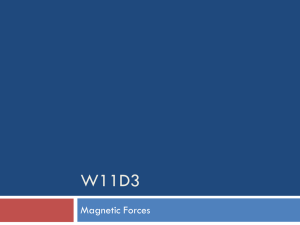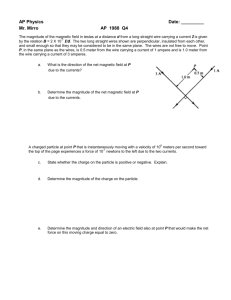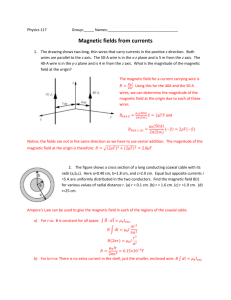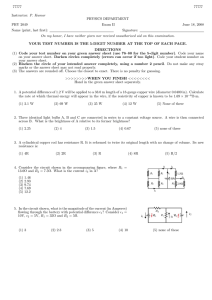Phy 2049 Summer 2009 Exam II Solutions
advertisement
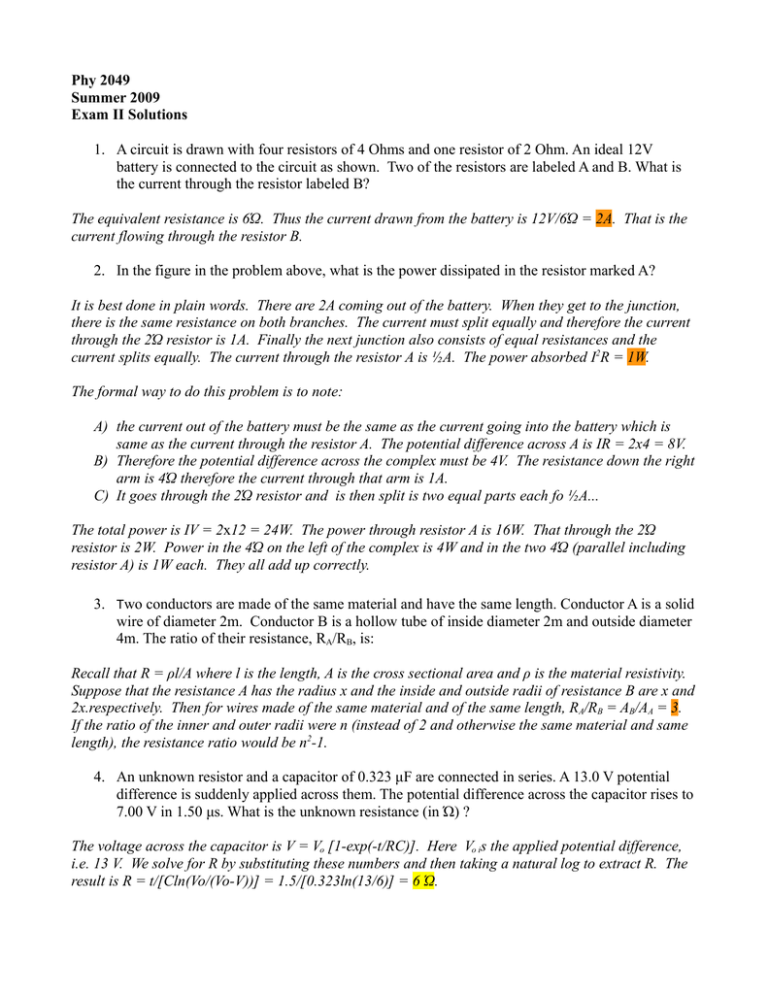
Phy 2049 Summer 2009 Exam II Solutions 1. A circuit is drawn with four resistors of 4 Ohms and one resistor of 2 Ohm. An ideal 12V battery is connected to the circuit as shown. Two of the resistors are labeled A and B. What is the current through the resistor labeled B? The equivalent resistance is 6Ώ. Thus the current drawn from the battery is 12V/6Ώ = 2A. That is the current flowing through the resistor B. 2. In the figure in the problem above, what is the power dissipated in the resistor marked A? It is best done in plain words. There are 2A coming out of the battery. When they get to the junction, there is the same resistance on both branches. The current must split equally and therefore the current through the 2Ώ resistor is 1A. Finally the next junction also consists of equal resistances and the current splits equally. The current through the resistor A is ½A. The power absorbed I2R = 1W. The formal way to do this problem is to note: A) the current out of the battery must be the same as the current going into the battery which is same as the current through the resistor A. The potential difference across A is IR = 2x4 = 8V. B) Therefore the potential difference across the complex must be 4V. The resistance down the right arm is 4Ώ therefore the current through that arm is 1A. C) It goes through the 2Ώ resistor and is then split is two equal parts each fo ½A... The total power is IV = 2x12 = 24W. The power through resistor A is 16W. That through the 2Ώ resistor is 2W. Power in the 4Ώ on the left of the complex is 4W and in the two 4Ώ (parallel including resistor A) is 1W each. They all add up correctly. 3. Two conductors are made of the same material and have the same length. Conductor A is a solid wire of diameter 2m. Conductor B is a hollow tube of inside diameter 2m and outside diameter 4m. The ratio of their resistance, RA/RB, is: Recall that R = ρl/A where l is the length, A is the cross sectional area and ρ is the material resistivity. Suppose that the resistance A has the radius x and the inside and outside radii of resistance B are x and 2x.respectively. Then for wires made of the same material and of the same length, RA/RB = AB/AA = 3. If the ratio of the inner and outer radii were n (instead of 2 and otherwise the same material and same length), the resistance ratio would be n2-1. 4. An unknown resistor and a capacitor of 0.323 μF are connected in series. A 13.0 V potential difference is suddenly applied across them. The potential difference across the capacitor rises to 7.00 V in 1.50 μs. What is the unknown resistance (in Ώ) ? The voltage across the capacitor is V = Vo [1-exp(-t/RC)]. Here Vo is the applied potential difference, i.e. 13 V. We solve for R by substituting these numbers and then taking a natural log to extract R. The result is R = t/[Cln(Vo/(Vo-V))] = 1.5/[0.323ln(13/6)] = 6 Ώ. 5. A wire having a mass per unit length of 0.500 g/cm carries a 2.00-A current horizontally to the south. What are the direction and magnitude of the minimum magnetic field needed to lift this wire vertically upward? The magnetic force on the current carrying wire IBl should be larger than the force of gravity mg and directed upwards to lift the wire. The minimum magnetic field is given by B = (m/l)g/I. Here the parenthesis translates into linear mass density, just what has been given at 0.05kg/m. In order for the force to be upwards, the field, by the right hand rule must be in the east direction. Its magnitude, from the above formula B = 0.05 x 9.8/2 = 0.25T. 6. A square wire loop of side length 10.0 cm carries a current of 10A. It is placed so that the normal to its plane makes an angle of 30˚ with respect to the direction of a uniform magnetic field of 4.0T. What is the magnitude of the torque acting on the loop in N-m? The torque is given by IA B sinθ = 10 x 10-2 x 4 sin 30 = 0.2 N-m. 7. Protons are accelerated through a potential difference of 2500 V and enter a magnetic field region at an angle of 30˚ relative to the field direction where they move in a helical path at a frequency of 285 Hz. What is the frequency of helical motion for 14C nuclei (6 protons, 8 neutrons) that are accelerated by the same potential in the same direction? Here note that (a) the frequency of helical motion f= qB/2πm. For 14C nuclei, the charge is 6 times that of a proton and the mass is 14 times that of a proton. So the frequency of helical motion of 14C nuclei must be = 285x 6/14 = 122 Hz. 8. In a uniform magnetic field, an electron undergoes a circular motion with a kinetic energy of 6.4 x 10-17J. The radius of the orbit is 23.0 mm. What is the magnetic field in T? Here R = p/qB where p is the momentum of the particle, i. e. p = √(2mE). Using this expression to get B = √(2mE) /qR = 2.93 mT. Is there any ambiguity here about the direction of this magnetic field? 9. Four long parallel wires are arranged on a plane, as shown in the attached figure, with 2.0 cm gaps between them. Each wire carries a 3.0 A current in the direction indicated by the arrow. On the wire labeled C, what is the magnetic force per meter in N/m? This is another TAL (take a look) problem. The force on C due to the adjacent wires (they both carry current in the same direction, against the one in C, therefore repel C in opposite direction) cancel. The only force that survives is the one due to wire A, F/l = 2 x 10-7 x 3 x 3/.04 = 45μN/m. 10. Two long straight wires, lined along the z axis and with separation d along the x axis, carry currents i1 and i2 = 2i1 out of the page. At what point on the x-axis is the net magnetic field due to the currents equal to zero? The magnetic field is given by its own right hand rule for direction and magnitude by the formula. With two wires carrying current in the same direction, the fields are in opposite direction only between the two wires. Therefore µ i 1 2 B= o1 − = 0 2π x d − x Where x is the distance from the wire with current i1. This leads to d-x = 2x or x = d/3. 11. In the figure, a current i = 10 A is set up in a long hairpin conductor formed by bending a wire into a semicircle of radius R = 1.0 mm. What is the magnitude and direction of B at a? The magnetic field due to a current carrying semicircle and two semi-infinite wires are all in the same direction and add up to, µ I π B = 0 1 + 2π R 2 The answer is 0.005T in to the page. 12. As a loop of wire with a resistance of 10 Ω moves in a non-uniform magnetic field, it loses kinetic energy at a uniform rate of 5mJ/s. The induced emf in the loop: The loss rate of kinetic energy is VI or V2/R = 5 mW. Therefore V = √(10 x 5 x 10-3) = 0.22V.

